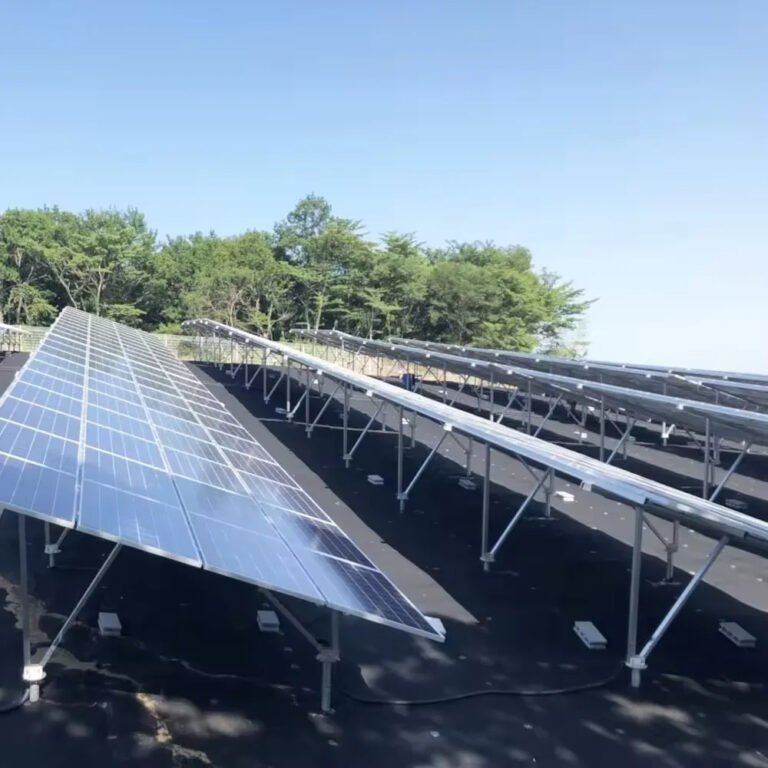-
2103 호실 322호 싱강 원 로드,하이창구,샤먼 푸젠,중국

Ground-Mounted Distributed PV Systems: Best Practices for Solar Brackets
Table of Contents
Ground-mounted distributed photovoltaic (PV) systems are a popular solution for utilizing idle land resources and generating clean energy on-site. Among the various components of these systems, solar brackets play a pivotal role in ensuring structural stability, optimal tilt angles, and long-term durability. Below is a comprehensive guide—complete with SEO-friendly headings—on how to select, install, and maintain solar brackets for ground-mounted PV projects.
The Importance of Solar Brackets in PV Projects
Solar brackets are the backbone of any ground-mounted PV system. They bear the weight of PV modules, maintain the correct tilt angle, and protect against external factors such as wind, rain, and snow. Proper bracket design and installation not only prolong the life of the array but also boost overall energy yield.
Structural Stability and Safety
- Foundation Requirements: Before installing brackets, perform a site inspection to ensure the soil can support the bracket foundation. Consider factors like soil density and slope to avoid structural issues.
- Wind and Snow Load: Select brackets that can endure local wind speeds and snow loads. A robust bracket system prevents damage to modules and reduces downtime.
- Material Durability: Hot-dip galvanized steel or aluminum alloys are commonly used. Both materials offer excellent corrosion resistance, a key factor in extending the life of the PV system.

Enhancing Energy Generation
- Optimal Tilt Angle: The bracket’s tilt angle should match site latitude and local solar irradiation patterns for maximum efficiency.
- Shadow Avoidance: Use shading analysis software to eliminate obstructions from buildings or vegetation, ensuring the brackets hold modules clear of potential shadows.
- Flexibility for Expansions: A well-planned bracket layout can accommodate phased capacity expansions, meeting future load demands without a complete redesign.
Design and Installation Guidelines
Selecting and installing the correct solar bracket system involves balancing technical viability, economic efficiency, and environmental adaptability. Below are key factors to consider during the design and construction phases.
Fixed vs. Tracking Brackets
- Fixed Brackets:
- Lower cost and simpler installation.
- Fewer moving parts reduce maintenance requirements.
- Ideal for sites with consistent solar exposure throughout the day.
- Tracking Brackets:
- Track the sun to maximize output, typically improving energy yield by 15–25%.
- More complex design requires additional operational and maintenance strategies.
- Recommended if your region has high solar irradiance and sufficient land for the additional space and equipment.
Foundation and Groundwork
- Concrete Footings: Common choice for level terrain and standard soil conditions.
- Single-Pile or Multi-Pile Foundations: Effective in areas with uneven terrain or higher wind loads.
- Drainage Considerations: Incorporate drainage channels to prevent waterlogging and erosion around the bracket foundations.
Corrosion Protection and Maintenance
- Material Coating: Hot-dip galvanization or anodized aluminum to resist rust and corrosion.
- Routine Checks: Inspect fasteners, joints, and module clamps for signs of wear. Promptly tighten or replace components to maintain system integrity.
- Long-Term Monitoring: Implement regular inspections—drones and robot cleaners can streamline this process. Early detection of bracket or module defects prevents larger failures.
Integrating the Brackets with the Electrical System
While brackets are primarily mechanical, their layout and design closely interact with the PV system’s electrical components. Proper coordination optimizes both safety and performance.
Cable Routing and Protection
- Cable Management: Secure DC cables from modules to the inverter in steel trays or conduits to avoid abrasions and ensure tidy arrangement.
- Avoid Multiple Cable Loops: Minimize looped conductors to reduce electromagnetic interference and improve system safety.
- MC4 Connectors: Use high-quality connectors for reliable performance under various weather conditions.
Earthing and Lightning Protection
- Earthing Network: Ensure brackets, module frames, and other metallic surfaces are all tied to a common grounding network.
- Lightning Arrestors: Install surge protection devices (SPD) in combiner boxes and at the inverter to protect against surges.
- Structural Bonding: Use hot-dip galvanized steel strips or cables for robust grounding, maintaining a ground resistance as per local regulations (often ≤4Ω).
Adapting to System Upgrades
- Capacity Expansion: Plan bracket layouts to accommodate future module additions without substantial reconstruction.
- Inverter Compatibility: Ensure the bracket design supports the required module string lengths and DC voltage ranges.
- Monitoring Integration: Seamlessly integrate bracket-based sensors (e.g., tilt or stress sensors) into the main data platform if advanced monitoring is desired.
Long-Term Performance and ROI
Reliability and Efficiency
A stable, corrosion-resistant bracket system will help maintain annual system efficiency—ideally ≥80% in the first year (accounting for nominal module degradation). Reduced downtime from bracket failures translates into higher energy yield and revenue over the project’s lifetime.
Cost-Effective Maintenance
- Preventive Maintenance: Schedule routine cleaning and inspections to deter rust or structural damage.
- Modern Tools: Utilize drone inspections and infrared cameras to detect hot spots or bracket misalignment.
- Warranties and Certifications: Require bracket suppliers to provide relevant ISO and TUV certifications. This ensures product performance, longevity, and compliance with safety standards.
Conclusion
In any ground-mounted distributed PV project, well-designed and properly installed solar brackets are crucial. They provide the structural foundation for the entire system, support optimal power generation, and safeguard against environmental stresses. By carefully selecting materials, adhering to local regulations, and implementing robust maintenance protocols, solar developers can maximize both system performance and return on investment.
By incorporating the above best practices—from foundation design to corrosion protection—you’ll set the stage for a highly efficient and durable ground-mounted distributed PV system.








